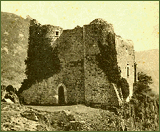|
Therefore the history of Paris
in the 14th century was dictated by outbreaks of plague, political violence and uprisings.
It was in the January of 1357 that Etienne Marcel, the Provost of Paris, led a merchants
revolt in a bid to curb the power of the monarchy and obtain privileges for the city and
the Estates General, which had met for the first time in Paris in 1347.
There were initially concessions by the Crown, but the city of Paris was retaken by
royalist forces in 1358, and Marcel plus his followers were subsequently killed.
In the aftermath of the revolt, Charles V of France took steps to guard against a
recurrence. There was a new city wall constructed to guard against exterior enemies
whilst the fortress of the Bastille was
built to control the city's restless population.
Under the reign of Charles VI of France, another revolt broke out in 1382, and this time
it was over excessive taxation, but this was quickly yet violently suppressed. The
Paris city was subsequently punished and had its earlier privileges withdrawn.
After the assassination of Louis of Valois the Duke of Orleans by the Burgundian, John the
Fearless, civil war broke out in France.
And in the chaos, the English captured Paris in 1420. But Henry V of England died at
the Chateau de Vincennes, just outside Paris city in 1422.
Charles VII of France tried but failed to retake the city in 1429, despite the assistance
of Joan of Arc, who ended up being wounded in the attempt. And it was the following
year that Henry VI of England was crowned King of France at the Notre-Dame.
Yet the persistence of the French paid off when Charles VII finally managed to retake the
city in 1437 after several failed sieges.
With the recapture of the city, the Valois monarchs and French nobility sought to impose
their authority on the city through the construction of various grand monuments, including
mansions and churches. However, even with these developments, the later Valois
dynasty largely abandoned Paris as their place of residence, preferring instead to reside
in various Renaissance chateaux in the Loire Valley
or the Parisian countryside and over the following century the city's population over
tripled.
Of any Valois monarch, Francois I probably had the greatest impact on Paris, transforming the Louvre and establishing a glittering court
including people such as Leonardo da Vinci.
Paris was, however, not spared from the religious violence affecting the rest of the
country as although a predominantly Catholic city, it also had a growing Protestant
population. The rival religious factions pursued an increasingly bloodthirsty feud,
with assassinations and burnings at the stake.
Everything came to a head on 23 August 1572 with the St Bartholomew's Day Massacre, when
Catholic mobs killed an estimated 3,000 Protestants on the instructions of King Charles
IX.
King Henry III, the successor of King Charles IX, attempted to find a peaceful solution
but the Paris population turned against him and forced him to flee in May 1588. King
Henry III was assassinated the following year by a Dominican monk, which brought the
Valois line to a premature end.
|
|



